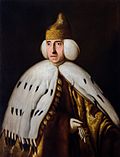Doge of Venice
| Doge of Venice | |
|---|---|

Coat of arms
|
|
| Style | His Serenity |
| Residence | Palazzo Ducale |
| Appointer | Serenissima Signoria |
| Formation | 697 |
| First holder | Paolo L. Anafesto |
| Final holder | Ludovico Manin |
| Abolished | 12 May 1797 |
The Doge of Venice (/ˈdoʊdʒeɪ/; Venetian: Doxe de Venexia [ˈdɔːze de veˈnɛsja]; Italian: Doge di Venezia [ˈdɔːdʒe di veˈnɛttsja]; all derived from Latin dūx, "military leader"), sometimes translated as Duke (compare the Italian Duca), was the chief magistrate and leader of the Most Serene Republic of Venice for 1,100 years (697-1797).
Doges of Venice were elected for life by the city-state's aristocracy. Commonly the man selected as Doge was the shrewdest elder in the city. The doge was neither a duke in the modern sense, nor the equivalent of a hereditary duke. The title "doge" was the title of the senior-most elected official of Venice and Genoa; both cities were republics and elected doges. A doge was referred to variously by the titles "My Lord the Doge" (Monsignor el Doxe), "Most Serene Prince" (Serenissimo Principe), and "His Serenity" (Sua Serenità).
According to the chronicler John the Deacon, author of the Chronicon Venetum ("Chronicle of Venice"), written about 1000 AD, the office of the Doge was first instituted in Venice in 726, replacing tribunes that had led the cluster of early settlements in the lagoon. Whether or not the first doges were technically local representatives of the Emperor of Constantinople, the doge, like the emperor, held office for life and was similarly regarded as the ecclesiastical, the civil and the military leader, in a power structure termed caesaropapism.
...
Wikipedia

